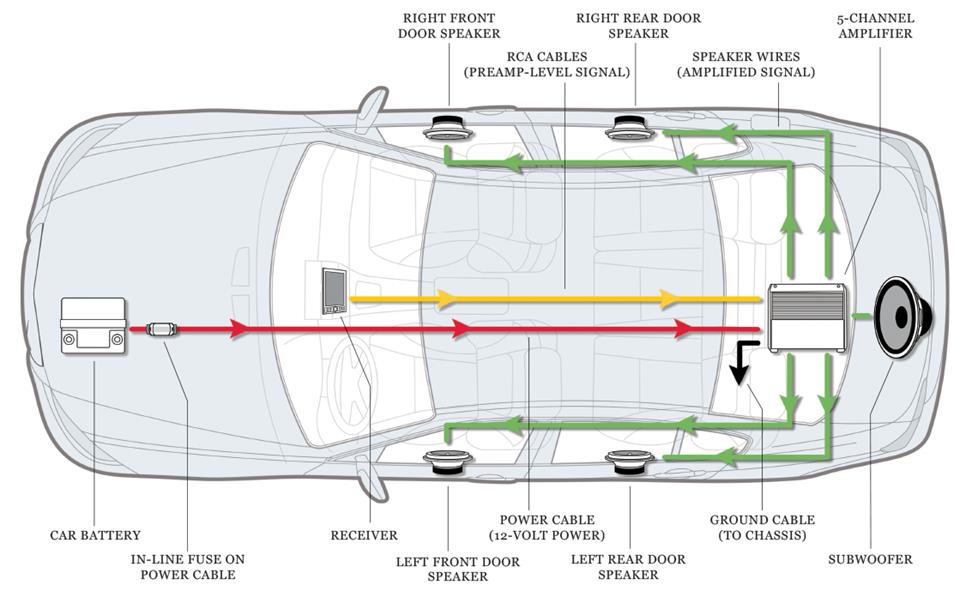Car Subwoofer & Amp Installation Guide
Want to transform your car into a rolling concert hall? Adding a subwoofer and amplifier can dramatically enhance your car audio experience, delivering powerful bass and richer sound quality. While it might seem intimidating, wiring a subwoofer and amp isn't rocket science. This guide will break down the process, offering clear steps and helpful tips to get you thumping in no time.
So, what's the big deal about subwoofers and amps? Factory car stereo systems often lack the low-end frequencies that truly bring music to life. A subwoofer is designed specifically to reproduce these frequencies, adding depth and impact. An amplifier provides the extra power needed to drive the subwoofer effectively, resulting in a fuller, more dynamic sound.
Connecting a subwoofer and amp has been a popular car audio upgrade for decades. Early car audio enthusiasts often built their own systems from scratch, but today, a wide range of pre-built components and wiring kits make the process much more accessible. While the technology has evolved, the basic principles remain the same: getting the right signal and power to your subwoofer.
One of the most common issues people face when installing a subwoofer and amp is dealing with tangled wires and choosing the correct gauge for power and speaker cables. Improper wiring can lead to poor sound quality, blown fuses, or even damage to your car's electrical system. This guide will help you avoid these pitfalls and ensure a smooth installation.
Before diving into the installation process, let's define some key terms. An amplifier boosts the audio signal from your car stereo to power the subwoofer. The subwoofer is a specialized speaker designed for low-frequency sounds. A crossover network filters the audio signal, sending the low frequencies to the subwoofer and the higher frequencies to your car's other speakers.
Benefits of adding a subwoofer and amplifier:
1. Enhanced Bass: Experience the full impact of your music with deep, powerful bass that you can feel.
2. Improved Sound Quality: A dedicated amplifier takes the strain off your car stereo, allowing it to focus on reproducing higher frequencies more clearly, resulting in a richer, more balanced soundstage.
3. Customization: You can fine-tune your audio system to your preferences, adjusting the bass level, crossover frequency, and other settings to create the perfect sound.
Step-by-Step Installation Guide:
1. Gather Your Supplies: Amplifier, subwoofer, wiring kit, RCA cables, speaker wire, crossover (if not built into the amp), tools.
2. Prepare Your Car: Disconnect the negative battery terminal. Locate a suitable mounting location for the amp and subwoofer.
3. Run Power Cables: Run the power cable from the battery to the amplifier, using a fuse near the battery.
4. Connect Ground Wire: Ground the amplifier to a clean metal surface on the car chassis.
5. Connect RCA Cables: Connect RCA cables from your car stereo's subwoofer output to the amplifier's input.
6. Connect Speaker Wire: Connect speaker wire from the amplifier's output to the subwoofer's terminals.
7. Connect Remote Turn-On Wire: Connect the remote turn-on wire from the amplifier to your car stereo's remote turn-on lead.
8. Set Gain and Crossover: Adjust the amplifier's gain and crossover settings according to the manufacturer's instructions.
9. Reconnect Battery: Reconnect the negative battery terminal and test your system.
Advantages and Disadvantages
| Advantages | Disadvantages |
|---|---|
| Improved Sound Quality | Cost |
| Enhanced Bass | Installation Time |
| Customization | Potential for Wiring Issues |
FAQ
Q: Do I need an amplifier for my subwoofer?
A: While some subwoofers have built-in amplifiers, a separate amplifier is generally recommended for optimal performance.
Q: What gauge wire should I use?
A: The appropriate wire gauge depends on the power of your amplifier. Consult the amplifier's manual for recommendations.
Q: How do I set the gain and crossover?
A: Refer to your amplifier's manual for specific instructions on adjusting these settings.
Q: My subwoofer isn't working. What should I check?
A: Check all connections, fuses, and the amplifier's power and ground wires.
Q: Can I install a subwoofer and amplifier myself?
A: Yes, with careful planning and the right tools, it is possible to install a subwoofer and amp yourself.
Q: What type of subwoofer is best for my car?
A: The best subwoofer depends on your car's size, your musical preferences, and your budget.
Q: Where should I mount my amplifier?
A: A common location is under the driver or passenger seat, or in the trunk.
Q: How can I prevent my subwoofer from rattling?
A: Ensure the subwoofer is securely mounted and that all panels and trim pieces are properly fastened.
Connecting a subwoofer and amplifier to your car stereo system is a rewarding project that can significantly improve your in-car listening experience. By following this guide and taking your time, you can achieve powerful, high-quality bass without breaking the bank or hiring a professional. While challenges may arise, a little patience and troubleshooting will get you enjoying your favorite music with the thumping bass you've always wanted. So crank up the volume and enjoy the ride!
Bowling ball cleaner recipe secrets for a perfect game
Mastering 3 digit addition with carry over printable worksheets and techniques
Waukesha wi churches a guide to finding your community













